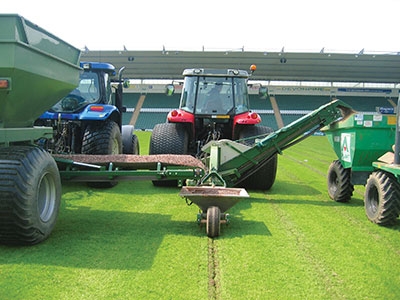
Features
Drainage Management Systems
Keep greens in play
Effective drainage techniques for unplayable courses
October 29, 2014 By Mick Claxton
 With System 25 The beautiful established scenery of an old golf course can rarely be beaten
With System 25 The beautiful established scenery of an old golf course can rarely be beatenThe beautiful established scenery of an old golf course can rarely be beaten, but history can come at a price when standing water threatens course closure. One thing we can all be fairly sure of is that weather patterns are changing and, global warming aside, that appears to be something that is here to stay.
As golf courses continue to be under increasing pressure for new membership, the ability to offer year-round play has to be an absolute given. The problem facing many old, established courses that were built before we all started to talk about greens built to United States Golf Association (USGA) specifications is that drainage systems were rarely installed in these older courses. At the time, golf was played infrequently and not at all in the wetter months.
“The majority of greens constructed in the last 30 years were built to USGA standards and consequently should drain well,” says Mick Claxton from Shelton Sportsturf Drainage. “In practice they were not all constructed with materials of the precise specification, so improvement to their drainage may be necessary. Many of the calls we get about drainage are from older, more established courses that were built prior to USGA specs.”
Drainage techniques are now so advanced that there are lots of options before a full green reconstruction should be considered. The main aim is to speed up the removal of excess water from the green without changing its character or original design features. Each situation is different, but if the problem is standing water on a green, we would generally suggest one of the following three options, all of which have been designed so greens can be back in play in a matter of hours or days, depending on the circumstances.
The Shelton Gravel Band System can be carried out during the months when the ground is wet. It is a very simple system that uses the Gravel Band Drainer and Lytag LWA as a backfilling material. Lytag LWA is sold in the United Kingdom and is a versatile lightweight aggregate which is produced from pulverised fuel ash, a by-product of coal burning power stations. It is an ideal medium for land drainage applications, as its rounded shape and regular grading give excellent hydraulic conductivity. Lytag LWA gets better results than gravel due to its rounded shape, and its ability to retain water in the drier summer months. (Alternatives to Lytag LWA are available in the United States). Closely spaced one-inch wide gravel bands lead to a piped drain situated just off the green. Bands of the Lytag LWA are injected into the green by a vibrating channel opener and, as no soil is removed, any surface undulations can be minimised by hollow tining prior to the installation. The beauty of this system lies in its simplicity and speed: a large green can be drained in five hours and played on 24 hours later!
System 25 is a versatile mini trencher used primarily for installing a secondary drainage system over a network of piped drains in a one-pass operation. System 25 may also be used to install land drainage tile and underground services. The trencher cuts a one-inch wide trench, removes the soil and lifts it into a trailer, whilst the Lytag LWA is simultaneously vibrated in. We would then suggest that a free draining top soil be applied over the drainage runs. This system generates fast results and, again, the damage to the green is minimal. In fact, the green can be played on 24 hours later – imperative in the busy summer months. We have seen this system used with great success at many clubs, including Farnham Golf Club in England. This system is carried out to best effect in the drier months.
The third option is a Lightning Drain system. This is very similar to System 25 except the trenches are dug to 1.4-inches wide and a one-inch perforated land drainage tile is installed prior to backfilling with Lytag LWA. This gives greater longevity to the system and also speeds the flow of water out to the exit drain. The results are immediate and with good greens maintenance, including plenty of aeration, the effects will last for years to come.
Lightning Drain is a popular technique, not just because of its effectiveness, but also because its use isn’t restricted to any particular time of year, although for optimum results, colder, wetter months are best avoided, so the grass is able to re-establish well over the cuts. Lightning Drain was recently used with great effect at the beautiful Boyce Hill Golf Club in Benfleet, Essex, England.
Mick Claxton is a director of Shelton Sportsturf Drainage Ltd. For more information, visit www.sheltonsdrainage.com.
Print this page